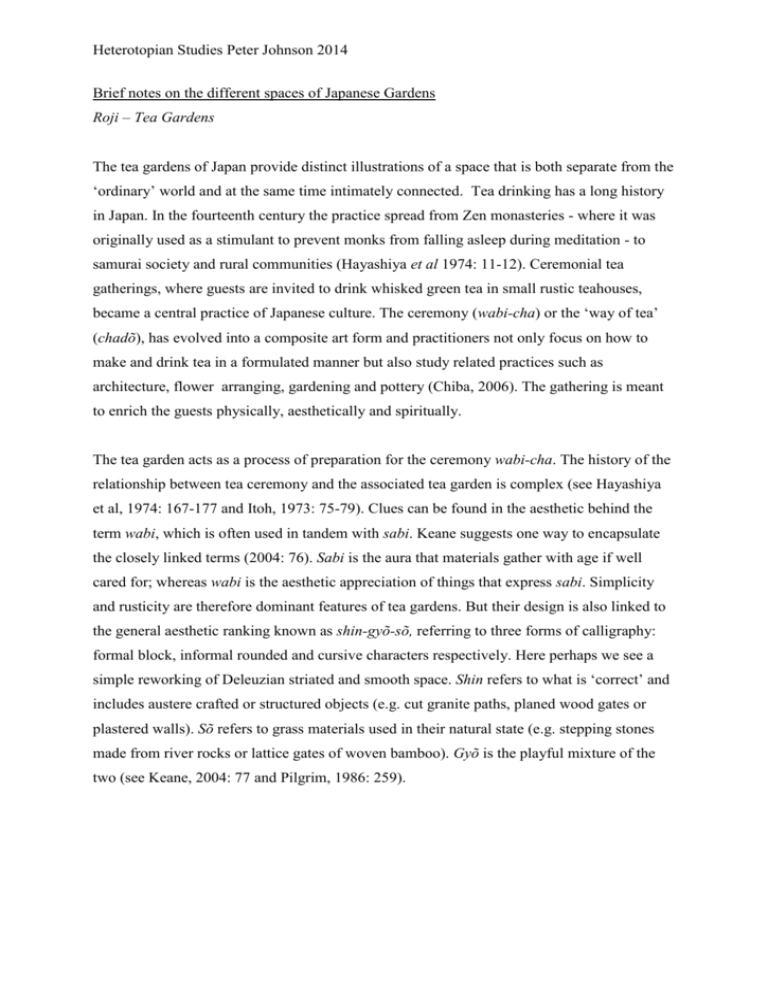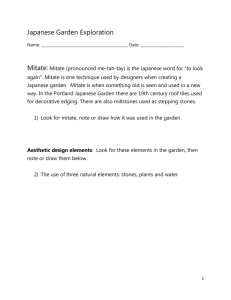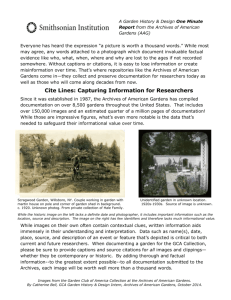Japanese Gardens - Heterotopian Studies
advertisement

Heterotopian Studies Peter Johnson 2014 Brief notes on the different spaces of Japanese Gardens Roji – Tea Gardens The tea gardens of Japan provide distinct illustrations of a space that is both separate from the ‘ordinary’ world and at the same time intimately connected. Tea drinking has a long history in Japan. In the fourteenth century the practice spread from Zen monasteries - where it was originally used as a stimulant to prevent monks from falling asleep during meditation - to samurai society and rural communities (Hayashiya et al 1974: 11-12). Ceremonial tea gatherings, where guests are invited to drink whisked green tea in small rustic teahouses, became a central practice of Japanese culture. The ceremony (wabi-cha) or the ‘way of tea’ (chadõ), has evolved into a composite art form and practitioners not only focus on how to make and drink tea in a formulated manner but also study related practices such as architecture, flower arranging, gardening and pottery (Chiba, 2006). The gathering is meant to enrich the guests physically, aesthetically and spiritually. The tea garden acts as a process of preparation for the ceremony wabi-cha. The history of the relationship between tea ceremony and the associated tea garden is complex (see Hayashiya et al, 1974: 167-177 and Itoh, 1973: 75-79). Clues can be found in the aesthetic behind the term wabi, which is often used in tandem with sabi. Keane suggests one way to encapsulate the closely linked terms (2004: 76). Sabi is the aura that materials gather with age if well cared for; whereas wabi is the aesthetic appreciation of things that express sabi. Simplicity and rusticity are therefore dominant features of tea gardens. But their design is also linked to the general aesthetic ranking known as shin-gyõ-sõ, referring to three forms of calligraphy: formal block, informal rounded and cursive characters respectively. Here perhaps we see a simple reworking of Deleuzian striated and smooth space. Shin refers to what is ‘correct’ and includes austere crafted or structured objects (e.g. cut granite paths, planed wood gates or plastered walls). Sõ refers to grass materials used in their natural state (e.g. stepping stones made from river rocks or lattice gates of woven bamboo). Gyõ is the playful mixture of the two (see Keane, 2004: 77 and Pilgrim, 1986: 259). Heterotopian Studies Peter Johnson 2014 Figure 6 Japanese tea garden, with water laver (tsukubai) for guests to ritually cleanse their hands and mouth, Matsuoke, Aichi (Keane, 2004: 68). The tea garden itself is called a roji which traditionally means a path or alleyway. In fact, by definition the roji is not really a garden but more a passage or entrance to the tea house. The walk through this corridor is meant to compress the sensation of travelling from a town to a hermit’s hut (dewy path). It symbolises the actual journeys made by priests as they scrambled across streams and mountains to reach their hermitages (fig 6). For merchant and samurai classes in the sixteenth and seventeenth century it was a way of bringing the tranquillity of the mountain place within the bustle of city life (Chesshire, 2005: 122). Apart from a sense of calmness, the passage also involves a series of thresholds through which each guest is encouraged to release worldly concerns and increasingly enter a ‘tea state of mind’. The initial threshold is the outer gate that separates the roji from the profane external world. The last guest closes and locks the gate. In Keane’s words, they are now ‘no longer of the ordinary world’ (2002: 57). Guests must then sit, wait and reflect on their surroundings before being signalled by their host to enter the inner roji through the middle gate which is more a symbolic marker than a physical barrier. Within this inner space, guests pass through two thresholds of purification. First they use a tsukubai, water basin, to rinse their hands and mouth (Hibi:, 1989: 266). Tsukubai is derived from the verb ‘to crouch’ and guests must bow Heterotopian Studies Peter Johnson 2014 low as part of the ritual of purification. They pass a ‘dust pit’, in which they are meant to leave any troubles or worldly affairs before entering the tea house. The last threshold is a narrow crawl-through entry to the tea house. A square opening is found low in the wall which forces the guest to duck and bow in an act of humility when entering the tearoom (81-82). The tea garden therefore enacts a process, a passage that interrupts daily life. It incorporates gradual, difficult steps towards a different space. Ma – Time and Space More widely than the roji, many Japanese gardens are also designed to incorporate intervals called ma, a complex term with a variety of meanings involving both time and space and which has started to receive serious attention both inside and outside Japan (Pilgrim, 1986: 255). The term refers to an interval between two or more spatial or temporal things or events. It therefore involves measurement but also suggests a gap, pause, opening and perhaps again a play of smooth and striated. As well as a descriptive term, it also has a more subjective, relational meaning of being among or between others. Ma can therefore refer to the punctuation movement in Japanese dance or Noh theatre, the points of silence in Japanese music, or the distance between host and guest during a tea ceremony. In Japanese gardens ma can be produced as one moves through or contemplates the space (Keane, 2002: 132), but it can also refer to an imaginary or creative ‘negative’ space (Pilgrim. 1986: 259-60). With its spatio-temporal dynamic the tea garden exemplifies particularly well the sense of ma as a bridging or transforming space. In a variety of Japanese arts, ma refers to the ‘power, interest, depth’ that breaks through the ‘gaps, cracks and intervals in space and time’ (Pilgrim: 261). Here the garden becomes a ‘no-man’s land’, a crevice between worlds, opening up a pregnant space of difference. Kare-san-sui - allegorical models Other types of Japanese gardens form distinct spatial microcosms (see Itoh, 1972). Chinese culture and, in particular, Buddhism ,which is traditionally said to have been introduced into Japan in the mid fifth century, strongly shaped Japanese garden design. For example, at this period Japanese gardens started to create spaces as miniature representations of the Buddhist cosmos. Later, through the influence of Zen thought, the distinctive dry landscape (Kare-sansui ) gardens developed (Hayakawa, 1973: 74). Kare-san-sui means dry-mountain-water, a composite depiction of mountains and water, without using real water. It is an abstract Heterotopian Studies Peter Johnson 2014 technique using, for example, rocks arranged upright to express a waterfall, or expanses of white sand to suggest the surface of water. But this is not just an attempt to represent water with rock or sand; the formulation is meant to capture the essence of water, to manifest the fundamental character of water more profoundly than actually using it (Yoshinaga, 1962: 20). In its medieval form, these spaces were ‘contemplation’ gardens (kansho-niwa), an emplacement to be viewed and reflected upon rather than physically occupied (Keane, 2002: 59). In this way the vastness of the world could be found through contemplation of the small garden: ‘the gardens they created provided an image of the universe’ (Berthier, 2000: 6). Kare-san-sui gardens are used as allegorical models, mirroring certain Zen precepts as well as tools for meditation. For instance, the slow and simple process of cleaning and maintaining the garden are also thought to produce calm and poise (Keane, 2002: 62 and Hayakawa, 1973: 74-76). Figure 7 Japanese contemplation garden (kare-san-sui), Ryõanji, Kyoto (Keane, 2004: 61) These gardens can be spatially austere. For example, within the famous garden of Ryõanji in Kyoto the terrain is completely flat and rigorously geometrical, containing 15 greyish rocks Heterotopian Studies Peter Johnson 2014 of various sizes on a sheet of light grey gravel (fig 7). The poignancy of the garden stems in part from a spotless cleanliness that is achieved through constant maintenance. The surface appears as a ‘miniaturised white ocean’ (Goto, 2003: 115). The composition of the rocks is very complex, combining several groups that produce a whole but also retain their independence. The arid, virtually empty space raises the question of whether it is actually a garden. It eschews vegetation and water and refuses all figurative shapes (Berthier, 2000: 3037). Parkes suggests that it is necessary to understand some of the complexities of ancient Chinese thought that underpin the creation of these gardens, in particular the lack of any sharp distinction between the animate and inanimate and between sentient and non-sentient beings (1989: 89 and 125). The garden presents the opportunity for becoming ‘haecceity’, an assemblage of human and non-human elements. In Keane’s words: Our limits no longer defined by our skin, we become the moss, the sand, and the wall, the finely traced vine; the distant mountains ......’ (2002: 59) Without wishing to diminish the cultural and historical distinctions and subtle overlaps between Japanese gardens and those within the Western tradition (Tuan, 1974: 30), such a brief survey suggests that gardens over the centuries have been conceived as extraordinary places enclosing a variety of unsettling spatio-temporal dimensions. We find ourselves transformed into different places which are not utopian in the sense of promising something better in the future. They capture or combine or lead to something different in the here and now. They are markers of change that are deeply embedded in different cultures: interruptions in time and space. What is also striking is that the further we explore a certain example offered by Foucault, the more connections with other spaces are disclosed. For instance, Japanese tea gardens lead to remarks made about heterotopias that ‘presuppose a system of opening and closing that isolates them and makes them penetrable at the same time’, involving gestures and rituals of purification, as in the case of Muslim baths (Foucault, 1998a: 183). We are led to imagine more examples and connections, mapping an intricate web of heterotopias. There is no common thread, or essential hidden feature, but more a network of similarities overlapping and criss-crossing. Heterotopian Studies Peter Johnson 2014 References Berthier, F. (2000) Reading Zen in the Rocks, Chicago: University of Chicago Press. Goto, S. (2003) The Japanese Garden, New York: Peter Lang. Hayakawa, M. et al (1973) The Garden Art of Japan, Kyoto: Weatherhill/Tankosha. Hayashiya, T. et al (1974) Japanese Arts and Tea Ceremony, Kyoto: Weatherhill/Tankosha. Hibi, S. (1989) Japanese Detail: traditional architecture, gardens, interiors, London: Thames and Hudson. Itoh, T. (1972) The Japanese Garden: an approach to nature, Yale: Yale University Press. Itoh, T. (1973) Space and Illusion in the Japanese Garden, Kyoto: Weatherhill/Tankosha. Parkes, G. (1989) ‘The Role of Rock in the Japanese Dry Landscape Garden’ in F. Berthier (ed.), Reading Zen in the Rocks, Chicago: University of Chicago Press, 85-145. Pilgrim, R. (1986) ‘Intervals (“Ma”) in Space and Time: Foundations for a Religio-Aesthetic Paradigm in Japan’, History of Religion, 25 (3): 255-277. Yoshinaga, Y. (1962) Composition and Expression in Japanese Traditional Gardens, Tokyo: Shokokusha Publishing Pete Johnson Heterotopian Studies February 2014.








